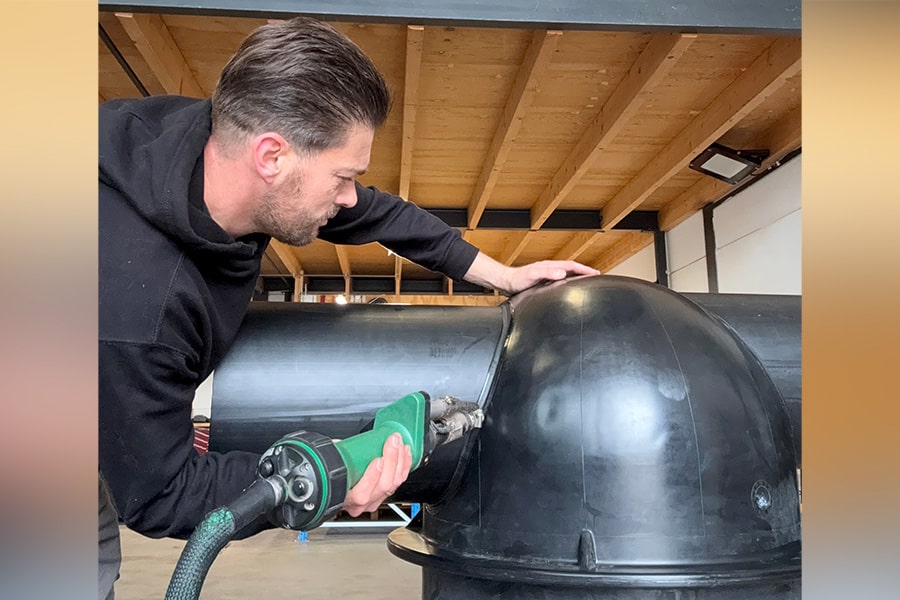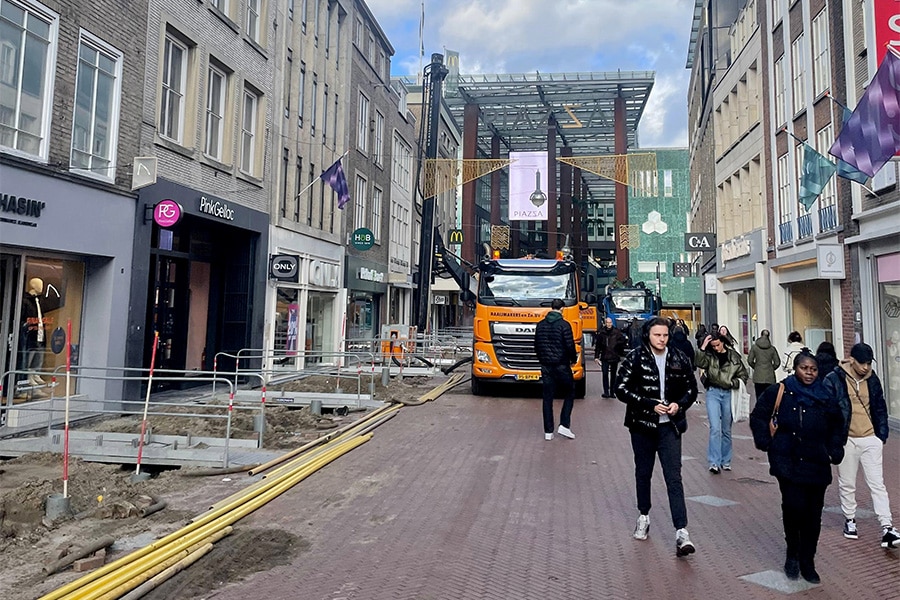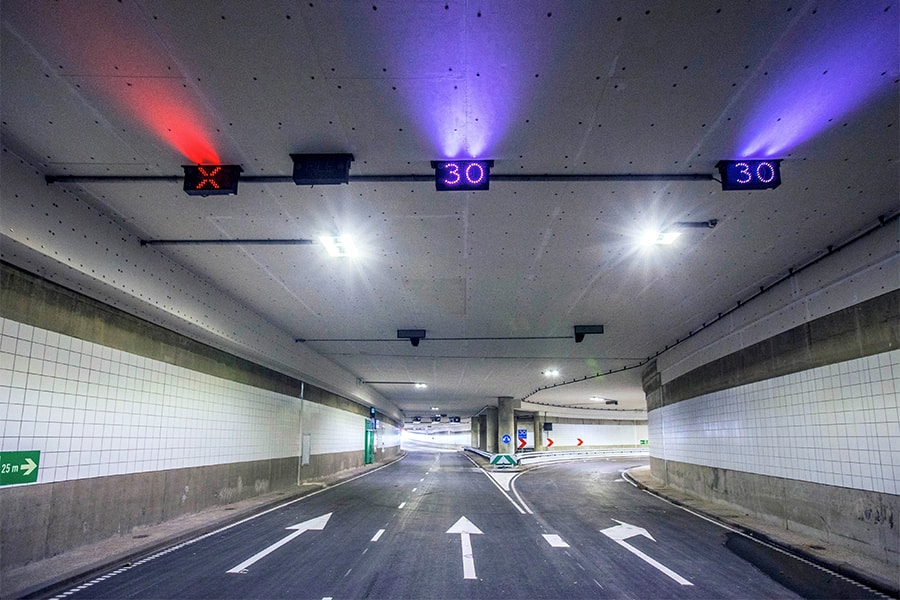
Groningen station gets underground passenger passage and bicycle parking
The main train station in Groningen is being converted into a modern public transport hub. A transfer square is planned directly behind the monumental station building, under the old platform roofs. From here, travelers can access the platforms via an underground passage and under the tracks to the south side of the city. "Next to this passage will be a bicycle tunnel and under the passage a large bicycle shed."

ProRail is delegated client on behalf of the cooperating parties: province of Groningen, municipality of Groningen, NS and ProRail, the project falls within the program 'Spoorplan Noord-Nederland'. The contract is in the hands of Strukton Civiel. Koen van Velsen architects and Royal Haskoning-DHV are providing the design. They are working with an integral construction team that also includes Fugro. The latter has been engaged from the tender phase, in order to deploy their geotechnical specialism. Fugro was preferred because of their local soil knowledge. Leon Schadee, Geotechnical Consultant at Fugro and Peter Nelemans, Lead Consultant/Project Director at Fugro talk about this special project.

From end point to transportation hub
"Groningen Station will soon no longer be a terminus, but a transportation hub with six tracks," Peter opens the conversation. "The marshalling yard has already been moved to make room for the six tracks and a bus hub." Leon adds, "Fugro is the geotechnical specialist for this project and engaged because of our local knowledge of the soil. We are very active in the north and also have an office there. We are taking our knowledge from other Groningen projects on this project. Our areas of expertise include design of foundations, pumping, excavations and their effects on the environment."

Pre-loaded clay layer
There is "potting clay" present at the site. Peter explains, "This is overconsolidated soil; the clay layer has a preload from the late ice age. If you remove the top layer, the clay layer starts to work. It swells and thus starts to move. It is precisely in this area that Fugro has in-depth knowledge. Removing the top layer or vibrating disturbs the soil equilibrium. We indicate what can and cannot be done." By probing and drilling and testing soil samples in laboratories, Fugro maps out what is present underground. To be well prepared, the construction team brought Fugro in as a member of this team as early as the tender phase. "Deformation of the ground must be prevented, since the monumental station is only seven meters from the construction pit," Leon continues. "Therefore, strict deformation requirements have been imposed, which will be addressed throughout the project. This requires a lot of calculations in advance. Strukton itself does the monitoring of the settlements, but Fugro has provided input by writing the monitoring plans."Excavation in two phases The first excavation concerns the southern part of the project and is now in progress, the second phase, the northern part comes next due to the rerouting of the track. "The northern part is the station. From south you enter at -1 with your bike," Peter said. At the same time, the passenger square forms the inter-neighborhood connection from the southern neighborhoods towards the city center. For a true bicycle city like Groningen, this is good news, of course." Leon: "There are therefore plans to develop south further. The station will thus become a connecting element." The ground level is at 2 to 3 meters + NAP, the excavation goes up to 10 meters - NAP. "So that means 12 to 13 meters of excavation."

Dealing with swelling
Leon explains how to deal with the swelling of the clay soil: "We first excavate dry to - 3 NAP (i.e. 5 meters from ground level), then water is put into the construction pit and the remaining excavation takes place 'in the wet'. This is necessary because the water pressure in the sand layer wants to push up - say: burst - the boulder clay layer, which is why we excavate in the wet, because of the counterpressure provided by the water in the construction pit." Only when you are at depth do you install the GEWI piles. These are tension piles for the underwater concrete. The swelling has already occurred by then, because of the limited thickness of the potting clay. The GEWI piles are installed from a pontoon, divers screw the dishes for attachment to the underwater concrete onto the piles. The construction pit is made with diaphragm walls, which are made before excavation. Diaphragm walls are made by digging a trench. Bentonite is pumped into the trench to prevent collapse. Then concrete is poured, a wall in the ground in other words, to absorb the ground and water pressure.

Fugro's vision for underground construction
According to Peter, underground construction has undergone a real evolution in the last decade. "Because of urbanization and improvements to livability, combined with climate adaptation, we are seeing more and more underground infrastructure. This in turn makes more space above ground for greenery. Infrastructural connections are therefore taking place underground, above, more greenery reduces heat stress and, because of a more natural environment, more natural water drainage takes place." Fugro is becoming increasingly involved in underground projects. "Where we used to have to zoom in mainly on construction risks, our expertise is now being asked to also look at short-, medium- and long-term environmental consequences. This is why we are increasingly working in multidisciplinary teams, because after all, we know more together than alone. We ensure that our practical knowledge within a team enables us to choose the most optimal working method. We also ensure that the right calculations are made and advise on how to work," Peter outlines. "That also means that we calculate more and more variants. Sometimes as many as ten parametric designs at the same time, because then we can compare the results. We deal with underground construction very differently today than we used to." Multidisciplinary work sometimes yields surprises Leon concludes that multidisciplinary work yields multiple perspectives. He explains: "By putting all the specialists together, you can choose the best solution. Sometimes that is surprising. In this way, for example, the bicycle parking was placed under the travelers' plaza instead of next to it. That offers many advantages, not only for the construction phasing, but it also saves a lot of space."
All in all, Groningen station is still a special project for Fugro, despite their extensive experience. Leon has been involved in the project for more than a year and a half and concludes, "Knowledge, experience and relying on consultants are becoming increasingly important. We see that right from the tender, many people from the various disciplines are being brought together to formulate answers to new questions that arise each time. The great thing is: together you know a lot and everyone learns from each other. The subject matter is interesting for everyone!"
Heeft u vragen over dit artikel, project of product?
Neem dan rechtstreeks contact op met Fugro.
 Contact opnemen
Contact opnemen




